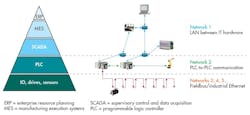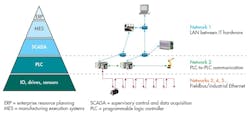TSN: Converging Networks for a Better Industrial IoT (.PDF Download)
Implementation of the Industrial Internet of Things (IIoT) certainly generates its share of challenges, one of the biggest being the convergence of information-technology (IT) and operational-technology (OT) networks. Currently, these networks exist in separate domains—dedicated gateways provide limited communication in each direction. To enable cyber physical systems, though, these networks need to converge, whereby nodes interact with each other using the IIoT.
The current architecture for controlling factory automation is hierarchical. Enterprise resource planning (ERP) applications at the highest level provide an integrated management and automation of business core processes, progressing down to manufacturing execution systems (MES) that control the manufacturing process. Programmable logic controller (PLC) systems execute the automation tasks using connected industrial devices like electric drives, sensors, or I/Os, which reside at the lowest level of the hierarchy.
These levels, as a whole, are often called the “Automation Pyramid” (Fig. 1), illustrating the broad amount of devices at the bottom and high-performance computers at the top. Layers of the pyramid illustrate the hierarchies.
1. The Automation Pyramid illustrates the typical assignment of networks to hierarchies.
Different layers in the pyramid have different network requirements. While higher layers need high bandwidth and flexible network topologies, lower layers need deterministic behavior and the capability to transport samples in constant intervals with low packet delay variation. This leads to multiple networks that work side-by-side.

